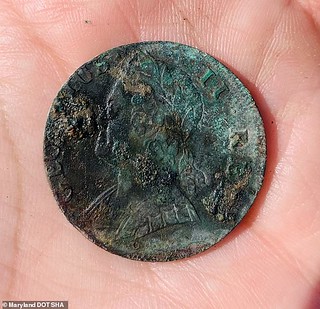
PREV ARTICLE
NEXT ARTICLE
FULL ISSUE
PREV FULL ISSUE
MORE ON THE MARYLAND JESUIT PLANTATIONVic Mason of Mamaroneck, NY submitted these thoughts on last week's item about discoveries in Maryland. -Editor
There was actually only one coin mentioned in the Daily Mail article, and the photo of it makes identification of its origins impossible for the average reader. Perhaps an expert reading this article or taking part in the dig can inform us what the coin is. All the artifacts recovered are described as belongings of the 272 slaves who lived there before being sold down the river in 1838 to a buyer in Louisiana. That sale apparently caused considerable consternation among some in the Jesuit community, both in Maryland and in Rome, because the priests "feared that the new owners would not allow the slaves to practice their faith." In fact, the leader of the Jesuits in the Vatican, one Reverend Jan Roothan, is quoted as writing: "It would be better to suffer financial disaster than suffer the loss of our souls with the sale of the slaves." That was an important consideration when everyone knew how a sale of slaves from the Northern or border states to the harsh conditions of the cotton-raising deep South, especially for field workers, usually resulted in much shorter life spans than elsewhere – not to mention the nearly inevitable break-up of slave families. I especially appreciated reading this article since writers on numismatic topics like to remind us that owning an old coin amounts to "holding a piece of history in our hands." Few note, however, that most important financial transactions before the Civil War necessarily had to have dimensions involving the use of slaves in construction, agriculture, trade, commerce, and other daily economic activity. Furthermore, the gold coins that began to be minted in 1838 in Charlotte, North Carolina, and Dahlonega, Georgia, came from mines on lands from which the peaceable Southeastern tribes of Native Americans -- such as the educated, Christianized Cherokees – were expelled, as we know from the stories about the "Trail of Tears" to Oklahoma. And history tells us that many of those Indians were also eventually enslaved to do the tough work of mining and agriculture. Joseph J. Ellis, author of the 2001 Pulitzer Prize-winning book Founding Brothers, notes that at the time the United States was founded, at least two-thirds of the value of all property in the 13 colonies came from the value of the slaves themselves – not the land. Thus, America's "capitalist democracy" was mainly based on enslaved human capital. The logical contradiction of demanding freedom from King George III in 1776, while denying it to millions of African slaves, finally produced, 85 years later, the most terrible internal conflict this country has ever faced. Scott Sery writes: "I was stunned to learn in that article that money from the 1830 sale of 272 slaves (to the tune of 3.3 million in today's dollars) went to pay debt at Georgetown University. There is no way this cannot sound political but seems to me that if reparations were to be paid, we need look no further than the very institutions demanding it...... Georgetown University for one."
Actually, Georgetown has begun making reparations to descendants of the slaves. Here are articles from The Atlantic and the New York Times. -Editor When sordid revelations surfaced in recent years of how the sale of hundreds of enslaved laborers in 1838 saved Georgetown University from the cliff of financial ruin, the college cobbled together a multipronged response. It summoned a working group to study how to make penance for the wrongdoing. It held a ceremony to deliver an official apology. It began giving descendants of the 272 enslaved people a bump in admissions. Last week, in a student referendum, undergrads voted overwhelmingly to tax themselves the symbolically significant amount of $27.20 per semester to create a fund that will support the descendants of the enslaved people from whom the university profited. Many of them live in rural Maringouin, Louisiana, where the median household income is less than $24,000, far below the national average.
To read the complete article, see:
Joining a wave of American institutions moving to offer a measure of restitution for their ties to slavery, Georgetown University announced on Tuesday that it would raise about $400,000 a year to benefit the descendants of the 272 enslaved people who were sold to help keep the college afloat nearly two centuries ago, officials said. Georgetown officials described the decision as one step in a dialogue with the descendants, who are seeking $1 billion for a foundation that would finance educational, health, housing and other needs. Dr. DeGioia said the university would continue to participate in those talks along with the Jesuits, who established and ran Georgetown and organized a slave sale in 1838 to help save the college from foundering.
To read the complete article, see:
To read the earlier E-Sylum article, see:

Wayne Homren, Editor The Numismatic Bibliomania Society is a non-profit organization promoting numismatic literature. See our web site at coinbooks.org. To submit items for publication in The E-Sylum, write to the Editor at this address: whomren@gmail.com To subscribe go to: https://my.binhost.com/lists/listinfo/esylum All Rights Reserved. NBS Home Page Contact the NBS webmaster 
|
